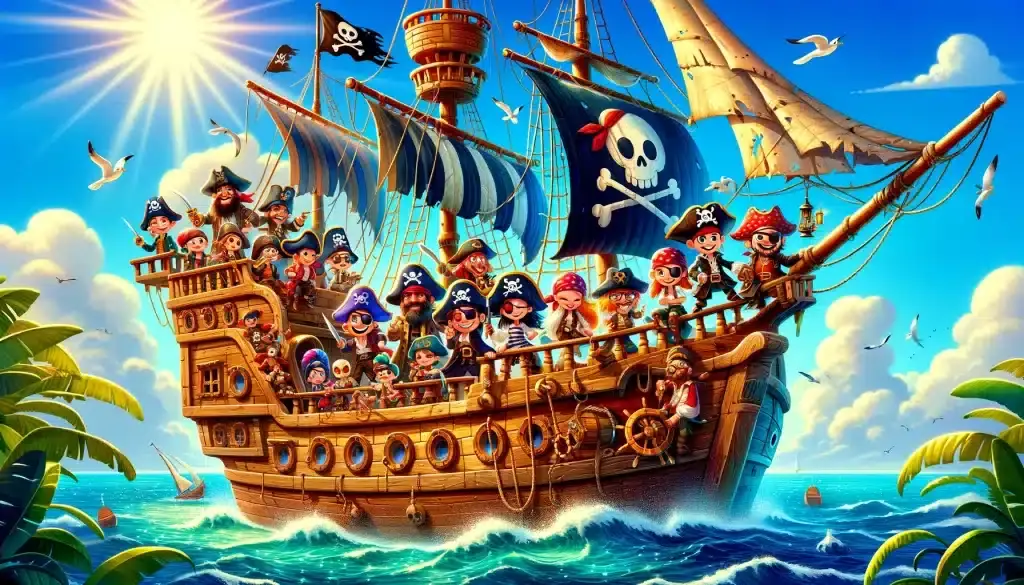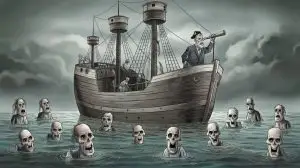The Real Pirates of the Caribbean. When we think of pirates, our minds often drift to swashbuckling heroes and villainous outlaws of the high seas, thanks in large part to Hollywood’s glamorous portrayal. But the real pirates of the Caribbean were far more complex and intriguing than any movie could capture. I’ve delved deep into history to uncover the truth behind these legendary figures, moving beyond the myths to reveal the reality of their lives and times.
The golden age of piracy is a period that’s both fascinating and misunderstood. From the notorious Blackbeard to the cunning Anne Bonny, the real stories of these pirates are often overshadowed by their fictional counterparts. But I’m here to set the record straight, exploring the true tales of treachery, treasure, and tyranny that defined the era. Join me as we embark on a journey to discover the real pirates of the Caribbean, beyond the Hollywood myths.
The Golden Age of Piracy: A Fascinating Era
The Golden Age of Piracy is often romanticized in film and literature, but when I delve into the facts, it’s clear this era was far more complex and intriguing than any movie could capture. Spanning from the late 17th century to the early 18th century, this period was a turning point in maritime history, shaping the way we view pirates today.
Pirates during this era weren’t just outlaws of the sea. They were skilled navigators and tacticians, operating in a realm without the rule of law. The Caribbean, rich with Spanish galleons laden with gold from the New World, became a hotbed for pirate activity. This wasn’t just about the allure of treasure; it was also a fight against oppressive colonial powers, giving rise to figures like Blackbeard and Anne Bonny, who’ve since become legends.
The fascinating aspect of this era lies in the communities pirates formed. Contrary to popular belief, pirate society was democratic, with captains often elected by their crew. This societal structure was ahead of its time, promoting a sense of equality and fraternity among outlaws. They enacted their own code of conduct aboard their ships, a stark contrast to the authoritarian rule found in the navies of the day.
These pirates also played a significant role in naval warfare, employed as privateers by competing European powers. Their intimate knowledge of the Caribbean waters made them invaluable, blurring the lines between legitimate combatants and outlaws. It’s this duality that makes the Golden Age of Piracy so fascinating.
Hollywood vs. History: Unveiling the Discrepancies

When we think of pirates, our minds often drift to swashbuckling heroes and villainous outlaws, thanks in large part to Hollywood’s cinematic portrayals. However, the real pirates of the Caribbean operated quite differently, and understanding these discrepancies between fact and fiction is crucial for appreciating the era’s true narrative.
One of the most glaring differences lies in the portrayal of pirates’ lifestyles. Hollywood often depicts pirates living lavishly, with an endless stream of treasure at their disposal. In reality, the life of a pirate was far less glamorous. Conditions on board were harsh, and spoils were scarce. Pirates faced constant threats, not just from the naval forces hunting them but also from diseases and the potential for mutiny.
Another common Hollywood trope is the romanticization of piracy, framing pirates as noble rebels fighting against oppression. While there were instances of pirates challenging colonial powers, the majority were motivated by survival or personal gain rather than grand political ideals. Pirate democracy, often highlighted in films, did exist but it was more a necessity for survival rather than an ideological choice.
Moreover, Hollywood’s depiction of pirates burying their treasure is largely a myth. Pirates preferred to spend their loot rather than bury it, with few recorded instances of treasure being hidden for later retrieval. This misconception has fueled countless treasure hunts but does little to reflect the pragmatic nature of piracy.
The real pirates of the Caribbean were skilled navigators and tacticians who played a significant role in the socio-political landscape of their time. They were not just outlaws but part of a complex ecosystem that included legal privateering and the slave trade. Acknowledging these facets is key to understanding the true legacy of Caribbean piracy beyond the embellished tales of Hollywood.
Notorious Pirates: Separating Fact from Fiction

When you think of pirates, names like Blackbeard, Calico Jack, and Anne Bonny might spring to mind, immortalized by Hollywood’s grand tales of adventure and rebellion. However, the true lives of these infamous figures were often markedly different from the swashbuckling heroes or villains portrayed on the silver screen. Let’s dive into the reality behind these legendary pirates, separating fact from fiction.
Edward Teach, better known as Blackbeard, was notorious for his fearsome image; tales suggest he lit fuses in his beard to appear more terrifying to his enemies. While this image has captured the public’s imagination, it’s important to note that much of Blackbeard’s reputation was carefully crafted by the pirate himself to instill fear without the need for violence. In reality, there are few records of him killing anyone outside of battle. His blockade of Charleston Harbor was more about strategy and less about the sheer love of chaos depicted in films.
Calico Jack is often celebrated for the iconic Jolly Roger flag, featuring a skull and crossed swords, which has become synonymous with piracy. However, his contribution to piracy was less about his success on the seas and more about the company he kept, particularly Anne Bonny and Mary Read, two of the most famous female pirates. Unlike their ruthlessly competent portrayal in movies, historical accounts suggest Calico Jack’s piracy career was relatively short-lived and less successful.
As for Anne Bonny and Mary Read, their involvement in piracy was groundbreaking, not because of their unparalleled success, but because of their defiance of contemporary gender roles. They were part of Calico Jack’s crew, and while Hollywood often exaggerates their escapades, their true legacy lies in their bold rejection of societal norms rather than an extensive list of piratical achievements.
The discrepancy between Hollywood portrayals and historical fact emphasizes the need to understand these individuals within their proper context. The life of a pirate was brutal, challenging, and, more often than not, short. Their stories, while certainly captivating, serve as a reminder of the complex human narratives that are often simplified in the search for a good tale.
Tales of Treachery, Treasure, and Tyranny

In exploring the real stories of piracy on the Caribbean seas, it quickly becomes evident that Hollywood’s portrayal scratches merely the surface of a much deeper, darker reality. Pirates, infamous for their deeds, lived lives entwined with treachery, treasure, and tyranny—elements far removed from the romanticized figures we often see on the big screen.
Treachery was as much a part of a pirate’s life as the very ships they sailed on. Betrayals were common, not just among rival pirate crews but within the same ranks. Trust was a commodity scarcer than the most elusive treasures. Tales of mutinies, backstabbing, and tactical deceptions fill the annals of pirate history, illustrating a world where one’s fate could change with the wind.
The pursuit of treasure, the most iconic aspect of piracy, was driven by a relentless hunger for wealth and the freedom it promised. But the truth behind these treasure hunts is that the bounties were often less glamorous than legend suggests. Gold and jewelry were part of the haul, but so were mundane items like food, supplies, and even medicine—essentials for survival at sea. It wasn’t just about wealth; it was about securing a future beyond the hangman’s noose.
Tyranny ruled the waves in the form of both pirate governance and the colonial empires’ efforts to control them. While some pirate captains were elected and operated under a set of rules agreed upon by their crew, others were tyrants who ruled through fear and violence. These authoritarian leaders were a stark contrast to the democratic processes seen on some pirate ships, highlighting a complex social structure rarely depicted accurately in popular media.
In delving into the true tales of piracy, it’s essential to peel back the layers of myth to reveal the gritty reality of life at sea. The stories of treachery, treasure, and tyranny not only paint a more authentic picture but also a more fascinating one, where the pursuit of freedom and fortune often came at a high price.
The Real Pirates of the Caribbean: Uncovering the Truth

In exploring the real lives of Caribbean pirates, I’ve unearthed stories that starkly contrast the glamorous Hollywood depictions. The truth is, the existence of these notorious figures was grounded in a harsh reality dictated by survival, brotherhood, and often a desire for liberation from oppressive regimes.
Pirate life was no treasure-laden adventure. Most pirates lived under the constant threat of death, whether from naval battles, disease, or betrayal. Life at sea was brutal, and the spoils of their conquests were not as plentiful as many believe. The romanticized chests brimming with gold were rare; more often, pirates sought provisions, weaponry, and goods to trade or sustain their voyages.
The social structure aboard pirate ships was surprisingly democratic. Crew members had a say in decisions, elected their captains, and could hold them accountable, a stark contrast to the rigid hierarchy of naval and merchant vessels of the time. This semblance of equality fostered a strong sense of camaraderie but didn’t wholly eliminate the threat of mutiny or deceit.
| Aspect | Reality |
|---|---|
| Treasure | Rarely gold, mostly provisions and trade goods |
| Social Structure | Democratic but prone to conflict |
| Lifestyle | Brutal, with constant threats of death |
Pirates also operated under a set of rules known as the pirate code, which varied from one crew to another. These codes regulated everything from the distribution of loot to the conduct in battle, providing a semblance of order amidst their lawless lives.
In my quest to unravel the true story of Caribbean piracy, I’ve found that understanding the motivations, societal norms, and harsh realities faced by these individuals is crucial. It’s a narrative that doesn’t shy away from the grit and grime, portraying pirates as humans striving for survival and autonomy in a world that offered them little.
Steve is the creative force behind My Unique Tales, a blog dedicated to sharing captivating stories that explore the human experience in all its complexity. With a passion for writing and a talent for crafting engaging narratives, Steve's blog is a treasure trove of imaginative tales that transport readers to other worlds and challenge them to see things from new perspectives. From epic adventures to intimate character studies, Steve's stories are always thought-provoking and emotionally resonant. With a growing following of readers who appreciate his unique voice and creative vision, Steve is quickly becoming a rising star in the world of online storytelling.






